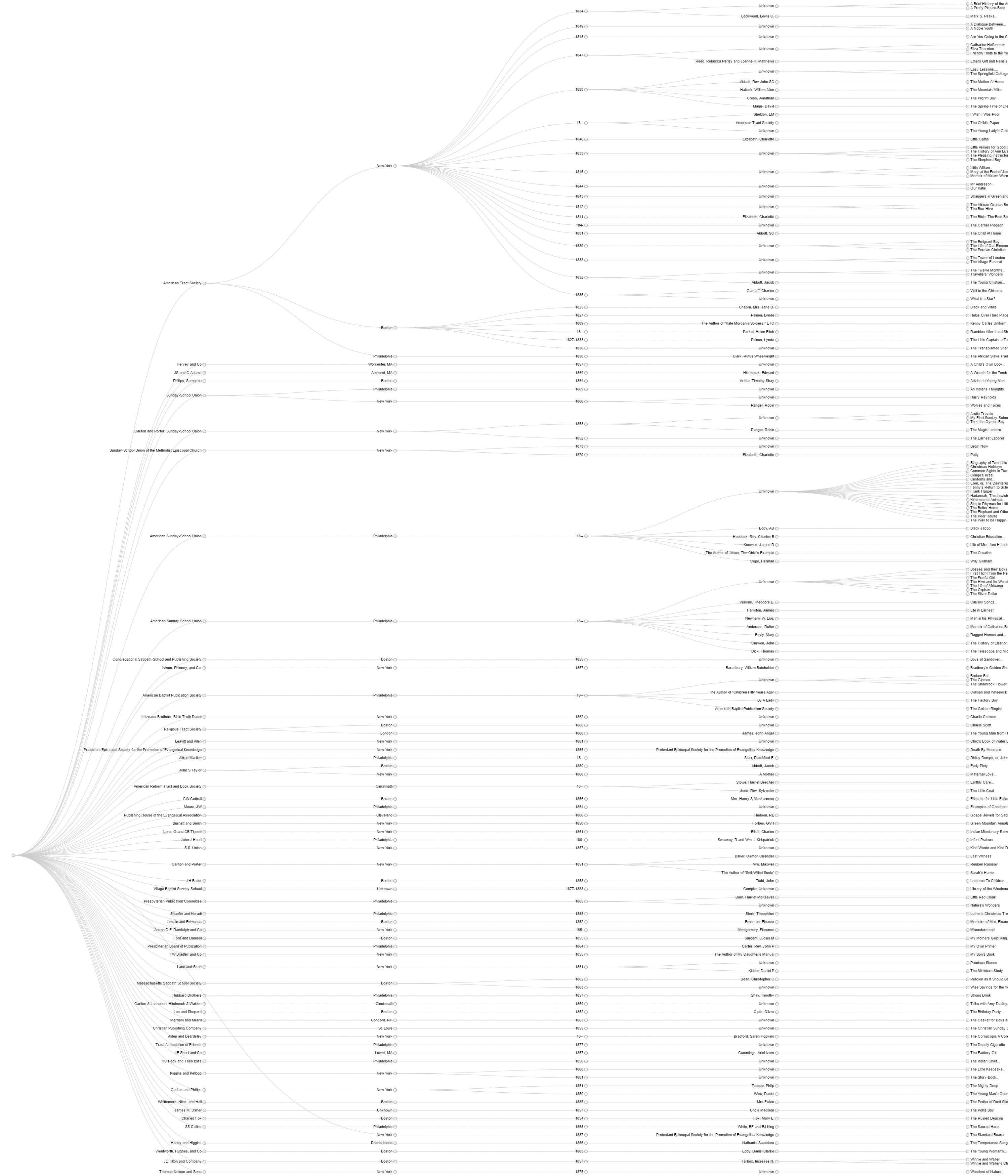Click on the graphical representation and zoom in to view specific data points.
Since the first half of this project was spent diving into the literary content of the sunday school book collection, we have decided to dive into other aspects outside of the texts themselves. This will give us a holistic perspective on how these books functioned within American society during the nineteenth century. An important building block of this research includes investing study in the linear relationships between the variables of our curated dataset. This graph, in it’s entirety, represents several variables, including: publisher, date, unknown authors, and their corresponding titles. Our original dataset contains several additional cells which we chose to exclude from this hierarchical graph in order to clarify our research as specifically nineteenth century, given that some of the authors were not published during the nineteenth century. We chose to place an emphasis on variation of unknown and known authors published by the same publishing houses during the nineteenth century. The main function of visualizing our data is to demonstrate the amount of books published with an unknown author by the well-known nineteenth-century publishers. We are curious to discover, through further research, what brought about this relationship by discovering and isolating the commonalities shared between these variables. If there are consistencies in relationships that we had not previously considered, our research will be furthered due to our ability to ask more informed questions.
Using this hierarchical data visualization, we discovered that the American Tract Society was the most popular publisher of it’s time period. We found that there was a strong geographical concentration in New York and Boston and determined which publishers had more of a monopoly on the market than others based off of their year. Throughout the nineteenth century, publishing unknown authors seemed to have been acceptable. The most predominate time periods includes the 1840’s through the 1870’s. The significance of the unknown authors is a question that we are interested in exploring. Were the authors really unknown? Did it have something to do with the fact that the literature in the data set is theologically challenging towards children? This may have been an impetus for the wide range of unknown authors, who may not have been unknown, but rather preferred to let their work live for itself rather than shoot for fame or glory by having their name attached to it. It also could have been that the publisher was attempting to hide that some or most of their literature was published by the same person, or even by people who would not have been appropriate authors to recognize, such as racial minorities.
Our modern-day assumptions lead us to believe that there are several factors furthering why these authors never claimed their work as their own. Often, established authors purposely do not claim their work while they are crossing into writing for different genres. In the nineteenth century, we argue that these Sunday School books marked as the building blocks to early developments of twentieth century youth ministry. As a result, it would be understandable if a secular author did not want their secular readers to place judgement on their religious works. Another speculation to the rise of unknown authors during this time period is due to doctrinal arguments in the Church. The nineteenth century sparked a rise in creation of different denominations. Perhaps the authors took an unknown name out of fear of being ridiculed by a publisher or the Church. In modern times, the most common reason to not claim authorship of a book is to separate their texts from earlier their works that were unsuccessful. We are curious to discover what brought about the relationship between unknown authors and their publishers. By seeing the relationships between all of the unknown data, we will be able to ask even more questions of our dataset. Through further research and our continuation of visualizing our collection, we hope to answer some of these questions.

